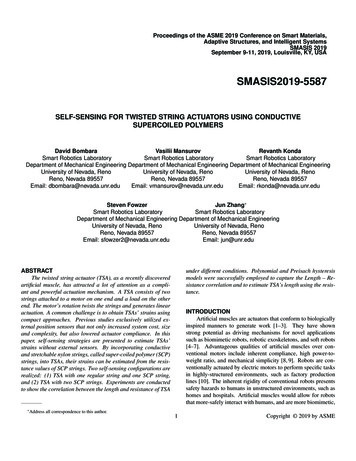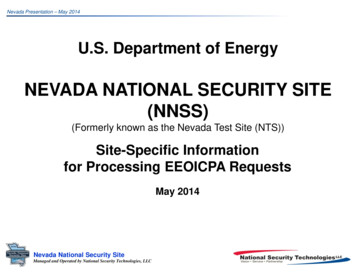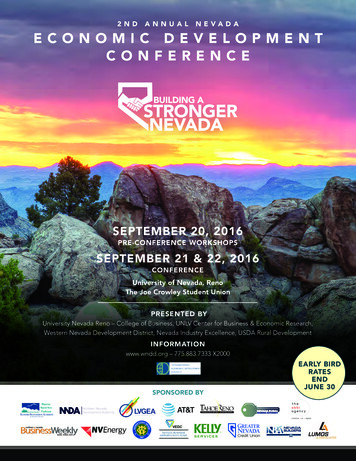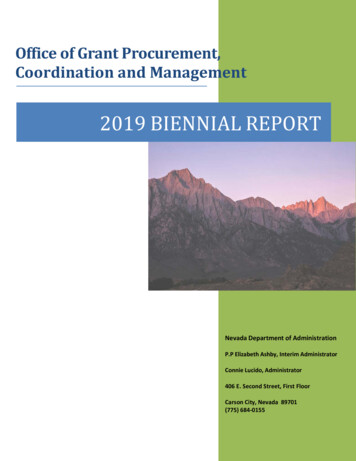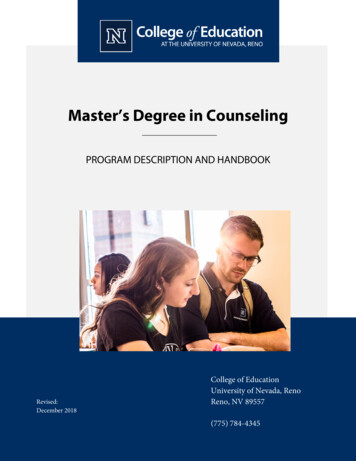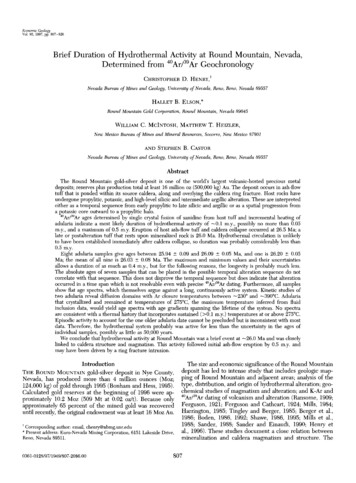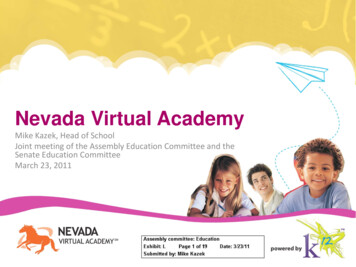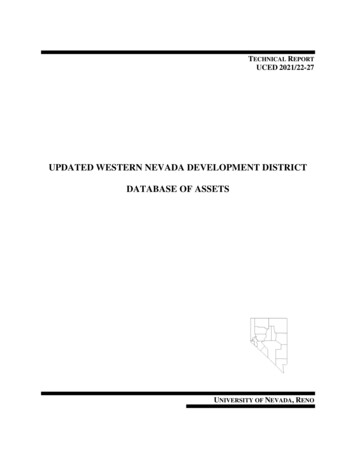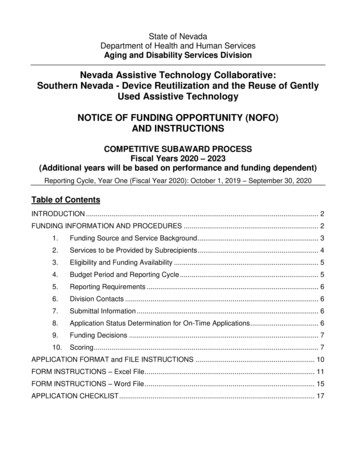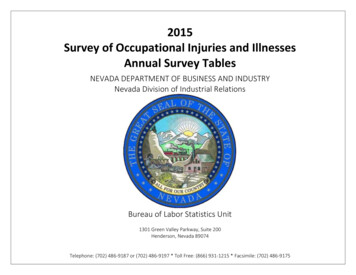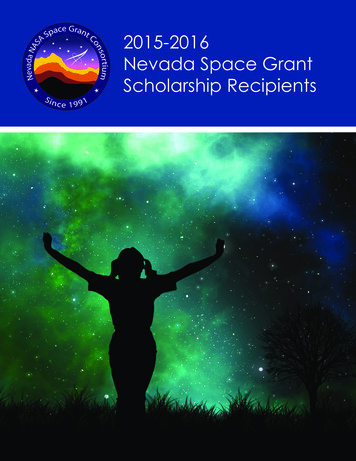
Transcription
2015-2016Nevada Space GrantScholarship Recipients
CONGRATULATIONS2015-2016 SPACE GRANT SCHOLARSSierra AdibiMulti Aircraft Simulator ProjectMichael BrionesIdentification of a germination receptor of the hypervirulent strain of Clostridium difficile through naturalmutagenesisChrisabelle CempronIncomplete Denitrification in Thermus Species fromYunnan Province, ChinaCarolyn ChangCharacterization of a novel species of Hydrogenobacter that is abundant in geothermal springs inTengchong, ChinaAriel FrielTectonic and climatic forcing of hydrological systemsin the southern Great Basin: Implications for ancientand future aquatic system resilienceArmon LatifiEffective Power Management of Harvested Power onSmall Unmanned Aerial VehiclesGrant MercerDeveloping a Data Visualization Tool for CALIPSOSatellite Aerosol DataAlex RollingsCharacterizing Topological Dark Matter Through Power Spectral DensitySarah ThorntonCsSnI3 As a Photocathode MaterialUNIVERSITY OF NEVADA, RENOMechanical EngineeringUNIVERSITY OF NEVADA, LAS VEGASBiological SciencesUNIVERSITY OF NEVADA, LAS VEGASMicrobiologyUNIVERSITY OF NEVADA, LAS VEGASBiologyUNIVERSITY OF NEVADA, LAS VEGASMicrobiologyUNIVERSITY OF NEVADA, LAS VEGASElectrical and Computer EngineeringUNIVERSITY OF NEVADA, LAS VEGASComputer ScienceUNIVERSITY OF NEVADA, RENOPhysicsUNIVERSITY OF NEVADA, LAS VEGASMechanical Engineering
ABOUT THE NEVADA SPACE GRANTRISE & HOP SCHOLARSHIP OPPORTUNITYThe Research in Science & Engineering and Hands on Projects (RISE & HOP)Scholarship Opportunity provides STEM students with 5,000 in scholarship support for the 2015-2016 academic year. Awardees must conduct a STEM researchor a hands on project under the guidance of a faculty mentor.Students engaged in any STEM area were encouraged to apply, however fieldsspecifically related to unmanned aerial systems, aeronautics (including highaltitude balloon projects), planetary geology, astrochemistry, astrophysics, astrobiology, biodiversity/biology, new satellite data systems, remote sensing, sustainability, agricultural science, climate change, hydrological impacts under achanging climate, and STEM education were of particular interest.Students are encouraged to participate in undergraduate and graduate research symposiums, poster sessions and oral presentations regarding their research/ project.
2015-2016 Nevada Space Grant Scholarship RecipientsSierra Adibi is in her senior year at the University of Nevada, Reno,where she is studying Mechanical Engineering. Sierra is highly involvedwith the aerospace organizations on campus, acting as the President ofUNR’s Chapter of the American Institute of Aeronautics and Astronautics.In the fall of 2016 Sierra plans to begin her doctoral work in AerospaceEngineering, focusing on dynamics and control systems. Sierra’s longterm aspiration is to become a professor of engineering, where she canshare her love for STEM and conduct research to develop UAVs capableof delivering vital relief supplies to conflict and disaster zones.For the RISE/HOP project, Sierra is designing and building afunctional physics and aerodynamics simulator. The simulator will becapable of handling multiple aircraft and interacting with other typesof algorithms. The simulator will then be used in conjunction with otheralgorithms to redefine the capabilities of small UAVs and study aircraftinteraction when multiple systems are in flight.Michael Briones: I am a senior at UNLV majoring in Biological Scienc-es and hope to graduate this coming Spring of 2016. I currently performresearch in the laboratory of biochemistry professor Dr. Ernesto Abel-Santos. My research focuses on understanding the mechanisms involved inspore germination of the bacterial species Clostridum difficile, a bacterium associated with many infections acquired in hospitals. The focus ofmy project this year is to identify a key gene that is associated with thevirulence of C. difficile. The identity of this gene will allow rational development of drugs that target this pathogen to preventing infection. After Igraduate, I hope to be enrolled in a dual doctorate and medical degree program (MD/PhD). I aspire to become a physician-scientist with acareer investigating infectious diseases.Chrisabelle Cempron is pursuing a Master’s degree in microbialecology and later hopes to earn a Ph.D in microbiology. Her researchfocuses on denitrification in high-temperature geothermal environments.Complete denitrification is the process by which nitrate is reduced todinitrogen gas (N2). Microbial production of nitrous oxide (N2O) in hotspring systems through truncated denitrification pathways is a significantsource of global greenhouse gas emissions. Her work aims untangle theimpacts of gene transfer on the evolution of denitrification genes in Thermus and determine ability of Thermus species to carry out denitrification.This study addresses several of NASA’s Astrobiology goals, by seeking toimprove our understanding of the limits at which life can exist and themechanisms by which microbes evolve at high temperatures. Her futureaspirations include a career as an academic scientist and the improvement of STEM education and the communication of scientific research tothe public.
2015-2016 Nevada Space Grant Scholarship RecipientsCarolyn Chang is a senior biology major at the University of Nevada,Las Vegas working for Dr. Brian Hedlund. Her project is to characterizenovel hyperthermophilic bacteria that were isolated from hot springs inTengchong, China.Carolyn will be graduating in Spring 2016 and plans to teach highschool biology and apply to the Peace Corps for environmental education before continuing her education and pursuit of a doctorate in a fieldrelating to microbiology.Ariel Friel: Currently, I am a Ph.D. student at the University of Nevada,Las Vegas in Dr. Brian Hedlund’s microbial ecology lab. My researchfocuses on the microbial diversity and archaeal biogeography of desertsprings in the southern Great Basin. I am fascinated with what limits life onEarth and I am interested in pursuing research within the field of astrobiology. Exploring the limits of life on Earth will give us a broader perspectiveof what it really means for an environment to be habitable. My ultimategoal is to pursue an assistant professor position so that I can begin tobuild my own astrobiology-focused research program.My project for this year will focus on the archaeal biogeographyobjective of my proposed Ph.D. research. We have chosen to work withArchaea, rather than Bacteria, for a variety of reasons. Not only are Archaea generally less hardy than Bacteria, but previous studies have alsobeen published demonstrating the existence of dispersal barriers andgeographical partitioning within this domain. I will be generating andsequencing archaeal clone libraries for two metabolic genes, the methyl-coenzyme M reductase (mcrA) gene and the ammonia monooxygenase large subunit (amoA) gene. After DNA sequencing, I will be ableto search for patterns of archaeal endemism and biogeographic rangewithin the data. Data will be analyzed within a 3-D model framework ofthe tectonic (14-1 Ma) and climatic (20-0 ka) evolution of the southernGreat Basin. This will allow me to explore past connections betweensprings and how they may influence current archaeal communities.Armon Latifi: My name is Armon Latifi, and my arrival as an under-graduate electrical engineer at the University of Nevada, Las Vegas, isa precursor of my deliberate research in embedded systems and computer architecture. Not only do I want my career to help many lives, butI wish to make a discernable mark in the field of electrical and computerengineering in the form of a published dissertation. Earning a doctorate’sdegree in electrical engineering would not serve as the pinnacle of myeducational pursuits, but instead as a continuation of my desire to helprevolutionize computer networks and architecture to the best of myability.During the spring semester of 2016, I will explore the possibility ofenergy harvesting of solar and vibrational energy and converting thiscollected energy to electric power supplied to a small Unmanned Aircraft System (sUAS). Because of this, I firmly believe that I the overall flighttime of the sUAS will be increased. Additionally, I will explore and implement a maximum power point tracker (MPPT) system for effective powermanagement. Testing, monitoring, and analyzing MPPT systems will occurduring various weather conditions.
2015-2016 Nevada Space Grant Scholarship RecipientsGrant Mercer is an aspiring Computer Science major at the Universityof Nevada, Las Vegas. He is entering his third year of attending university towards a Bachelor of Science in Computer Science, and hopes topursue a master’s degree at UNLV while considering the possibility of adoctorate. His interests lie primarily in open source projects and research;having recently worked on high performance systems with the STE ARgroup in 2014 and developing software visualization tools for NASA DEVELOP in 2015. Grant hopes to one day pursue a career in space relatedtechnology and continue working with open source projects to giveback to the community he is a part of.This fall and spring, Grant will be continuing development of thesoftware visualization project, named visualization of CALIPSO (VOCAL),that he led while working at NASA DEVELOP. The software is designed tovisualize data from the earth observations satellite CALIPSO, which collects atmospheric data scientists can use to study the effects and impactthat aerosols have on human health. The primary objective of the project is to package the tool into a ready-to-use state and have an officialrelease that scientists can begin using. Among releasing the tool to thepublic, there are a number of useful features that can be implementedthat will help transform how users access and manipulate data. Whiledeveloping VOCAL, Grant will also serve as an advisor for NASA DEVELOP and oversee any fall and spring teams that are assigned to continuedevelopment for the software.Alex Rollings: For six years I was employed at a manufacturing plantfor General Electric and worked my way up the ranks. I earned my A.S.degree while working and eventually decided to continue my educationfull time. I enrolled at UNR majoring in physics, and was introduced to Dr.Derevianko with whom I am conducting my current research on investigating dark matter. My project is to use software to build a model of various noisy signals for applications in searching for dark matter. This projectwill be the subject of my undergraduate thesis, which I will defend at theend of the 2016 Spring semester. Upon completion, I will be graduatingwith my bachelor’s degree and plan to atten graduate school.Sarah Thornton: My name is Sarah Thornton. I am a current Mechan-ical Engineering graduate student at UNLV and am taking classes towards my PhD. This semester I am taking an X-ray diffraction course, aninstrumental analysis course, and structure properties relationships inmaterials to help further my research. I hope to eventually work on largescale renewable energy projects.The perovskite I am researching is CsSnI3. I have developed aprocess and will begin depositing CsSnI3 by January. Testing of the material stability and determination of the band gap will begin by March. Iwill be spin coating CsSnI3 onto a glass slide before it is annealed. Usingthermal anneals I will test the stability of the material. UV/VIS will be usedto calculate the band gap before and after stability testing. By summerI will also be doing X-ray diffraction to determine the phase stability andgrain size/grain size changes.
Armon Latifi: My name is Armon Latifi, and my arrival as an under-graduate electrical engineer at the University of Nevada, Las Vegas, is a precursor of my deliberate research in embedded systems and com-puter architecture. Not only do I want my career to help many lives, but I wish to make a discernable mark in the field of electrical and computer
